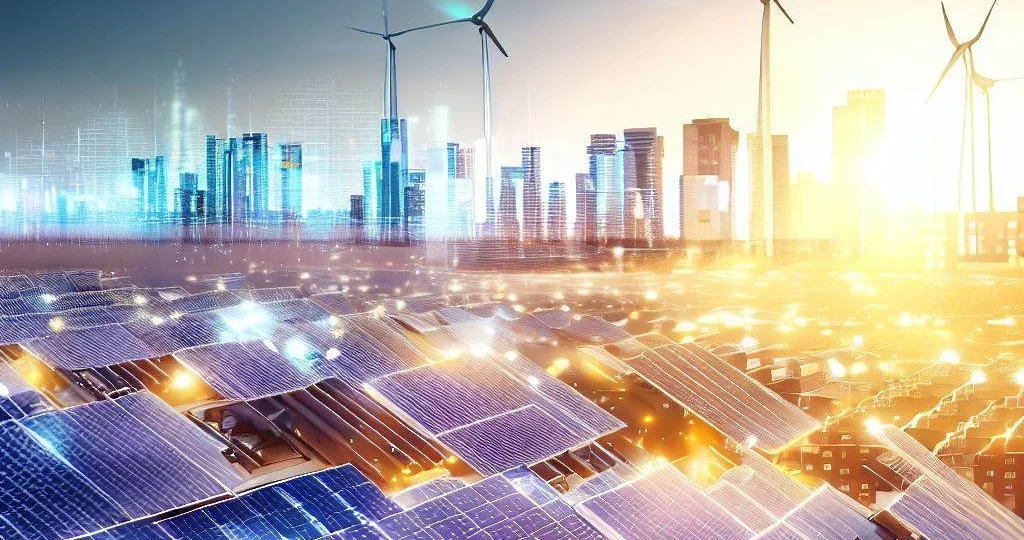Introduction
Welcome to NextechPulse, your ultimate source for the latest breakthroughs in technology and innovation. In a world where sustainability takes center stage, the marriage of Artificial Intelligence (AI) and sustainable energy solutions emerges as a beacon of hope. Our new article, “AI-Powered Energy Solutions: Innovating Sustainability,” uncovers the remarkable ways in which AI is revolutionizing the landscape of renewable energy.
Over the past decade, AI has evolved from a promising concept to a transformative force, driving advancements across various sectors. Within the realm of sustainable energy, AI’s potential to optimize, predict, and adapt has ignited a revolution that promises to reshape how we generate, distribute, and consume energy. In this article, we embark on a journey through the intricate web of AI applications in sustainable energy, exploring its profound impact on both technological innovation and environmental preservation.
From optimizing energy consumption in households to orchestrating complex smart grids that seamlessly integrate renewable sources, AI is a driving force behind the transition to a more sustainable energy future. Join us as we delve into the remarkable fusion of AI and sustainable energy, uncovering the ingenious solutions that are propelling us towards a cleaner and more efficient world.
Smart Grid Management: Revolutionizing Energy Distribution
The backbone of our modern energy infrastructure, smart grids, is undergoing a remarkable transformation, thanks to the integration of Artificial Intelligence (AI). These intelligent networks are no longer just about power distribution; they’re becoming intricate systems that optimize energy flow, enhance reliability, and ensure a greener energy future.
Traditionally, energy distribution systems operated in a somewhat linear fashion, with electricity flowing from power plants to consumers. However, this approach often led to inefficiencies, power wastage, and limited adaptability. This is where AI steps in as a game-changer.
By leveraging AI’s predictive capabilities, smart grids can now anticipate energy demand patterns and dynamically adjust energy distribution in real time. This not only minimizes energy losses during transmission but also ensures that power is channeled precisely where and when it’s needed the most. Imagine a city where energy surges during peak hours are managed seamlessly, reducing the strain on resources and minimizing outages.
Furthermore, AI’s ability to process massive amounts of data enables the integration of diverse energy sources, such as solar, wind, and hydroelectric power, into the grid. These sources, often intermittent and variable, require sophisticated management to ensure stable energy supply. AI algorithms analyze weather forecasts, consumption patterns, and grid health to make split-second decisions on when to tap into which energy source, ensuring a consistent and reliable energy supply.
AI also enhances grid security by identifying anomalies and potential threats, thereby reducing the risks of cyberattacks and physical breaches. Additionally, maintenance becomes proactive rather than reactive, as AI monitors equipment health and performance, predicting maintenance needs and minimizing downtime.
Renewable Energy Enhancement: Powering Tomorrow with AI
The quest for sustainable energy has led us to harness the power of renewable sources like solar, wind, and hydroelectric energy. However, the inherent variability of these sources has posed challenges in maintaining a steady and reliable energy supply. Enter Artificial Intelligence (AI), the driving force behind innovative solutions that maximize the potential of renewable energy sources.
AI’s predictive analytics and real-time adjustments are key in addressing the intermittency issues that come with renewable energy generation. Imagine a wind farm that uses AI to analyze weather patterns, wind speeds, and energy demand to optimize the positioning of its turbines in real time. This ensures that every gust of wind is converted into maximum energy output, increasing efficiency and reducing wastage.
Solar energy, too, benefits from AI’s insights. AI algorithms process data from solar panels, considering factors such as sunlight intensity, angle, and shading, to optimize their performance. This means solar installations can adapt to changing conditions, ensuring they generate the most energy throughout the day.
Moreover, AI-driven energy forecasting plays a crucial role in renewable energy integration. By analyzing historical data and current trends, AI can accurately predict when energy demand will surge or dip. This enables utilities to balance their energy mix in advance, ensuring a stable grid even during peak consumption.
Microgrids, which are localized energy distribution networks, are also benefitting from AI’s prowess. In remote areas or during emergencies, microgrids can use AI to determine the most efficient combination of energy sources to meet demand. These intelligent microgrids reduce reliance on traditional energy sources and contribute to a more resilient and sustainable energy infrastructure.
The synergy between AI and renewable energy is not limited to generation alone. AI-driven energy storage solutions optimize the storage and release of energy, ensuring excess energy is captured and used efficiently when needed. This reduces wastage and enhances the economic viability of renewable energy systems.
Energy Consumption Optimization: Empowering Efficiency through AI
In the pursuit of sustainable energy solutions, optimizing energy consumption stands as a critical pillar. Artificial Intelligence (AI) has emerged as a powerful tool to not only monitor but also significantly enhance energy efficiency in industries, businesses, and households.
AI’s data-driven insights allow for a granular understanding of energy consumption patterns. This enables businesses to identify energy-intensive processes, peak usage times, and areas where wastage occurs. Armed with this information, companies can implement targeted measures to reduce consumption and operational costs.
In households, smart meters equipped with AI algorithms provide real-time feedback on energy usage. This empowers homeowners to make informed decisions about their energy consumption habits, leading to reduced bills and a lower environmental footprint.
One notable application of AI in energy consumption optimization is demand response. AI systems can detect periods of high energy demand and automatically adjust consumption, such as temporarily reducing non-essential processes or adjusting temperature controls in commercial buildings. This not only helps prevent grid overload during peak hours but also rewards participants with financial incentives for their contribution to grid stability.
Predictive analytics play a significant role in optimizing energy consumption. AI models analyze historical data and external factors like weather forecasts to predict future energy demand accurately. This foresight allows energy providers to adjust supply in advance, minimizing energy wastage and ensuring that resources are allocated efficiently.
Industries with complex and energy-intensive operations are also benefiting from AI-driven solutions. By integrating AI into manufacturing processes, businesses can optimize production schedules, machinery usage, and energy-intensive operations, leading to substantial energy savings and reduced environmental impact.
Predictive Maintenance: Pioneering Equipment Longevity with AI
In the realm of sustainable energy solutions, the importance of maintaining energy infrastructure cannot be overstated. Enter Artificial Intelligence (AI) with its predictive maintenance capabilities, revolutionizing how we ensure the reliability and longevity of critical equipment.
Traditionally, maintenance practices followed fixed schedules or reacted to failures. This often resulted in either unnecessary maintenance, leading to resource wastage, or unexpected downtime, causing disruptions and increased repair costs. AI changes the game by introducing a data-driven approach.
By continuously monitoring equipment through sensors and analyzing data in real time, AI can detect subtle changes in performance patterns. These changes might be early indicators of potential failures. This allows for proactive maintenance interventions before a full breakdown occurs. For instance, in wind turbines, AI can identify vibrations or temperature anomalies that signal imminent issues, preventing costly breakdowns and reducing downtime.
The implications extend to the realm of renewable energy as well. Solar panels, which degrade over time due to weather and environmental factors, can benefit from AI’s predictive capabilities. AI algorithms analyze panel performance data and weather conditions to predict when maintenance or cleaning is needed to optimize energy production.
Furthermore, AI-driven predictive maintenance optimizes the use of resources. By focusing maintenance efforts precisely where they are needed, resources like manpower and replacement parts are utilized more efficiently. This reduction in waste contributes to the overall sustainability of energy operations.
Grid Integration Challenges: Navigating the Complexities with AI
As the world shifts towards sustainable energy solutions, the integration of diverse energy sources into the grid presents both opportunities and challenges. Artificial Intelligence (AI) emerges as a crucial tool in overcoming these complexities and ensuring a smooth transition towards a cleaner energy landscape.
Renewable energy sources like solar and wind are inherently intermittent, making their integration into the grid a delicate balancing act. AI’s real-time analytics can predict fluctuations in supply, helping grid operators adjust energy distribution to match demand. This minimizes disruptions and maintains grid stability even when renewable sources experience rapid changes in output.
One challenge in grid integration lies in managing the variability of demand and supply across different regions and time zones. AI-powered energy forecasting models consider factors such as weather, consumption patterns, and economic trends to accurately predict future energy needs. This information empowers grid operators to allocate resources effectively and prevent overloading during peak periods.
AI’s role in grid integration also extends to energy storage solutions. Batteries and other storage systems store excess energy when supply surpasses demand and release it when demand exceeds supply. AI algorithms optimize this storage and release process, ensuring that energy is used efficiently and effectively.
Moreover, AI is pivotal in enabling the integration of decentralized energy sources, such as rooftop solar panels in residential areas. These distributed energy resources require sophisticated coordination, which AI achieves by aggregating and managing their contributions to the grid in real time.
conclusion :
As we conclude this exploration into the innovative applications of AI in sustainable energy solutions, it’s clear that the synergy between technology and environmental stewardship is paving the way for a brighter future. The integration of AI into various facets of the energy sector – from smart grid management and renewable energy optimization to consumption efficiency and predictive maintenance – is transforming the way we generate, distribute, and utilize power.
The journey towards a sustainable energy landscape is not without its challenges, but AI’s remarkable ability to analyze data, predict outcomes, and optimize operations is proving invaluable in overcoming these hurdles. From enhancing the reliability of smart grids to ensuring the efficient utilization of renewable resources, AI is driving us towards a cleaner and more resilient energy infrastructure.
As we stand on the cusp of unprecedented technological advancements, we invite you to stay connected with NextechPulse. Through our in-depth exploration of the interplay between AI and sustainable energy, we’ll continue to deliver insights that illuminate the path towards a more environmentally conscious and technologically advanced world. Together, let’s harness the power of innovation to shape a future where energy sustainability is not just a vision, but a reality.
References:
1. Zhang, Z., Chen, J., Zhou, Z., Tang, Z., & Chen, H. (2020). Artificial Intelligence in Smart Grid: A Comprehensive Review. IEEE Transactions on Industrial Informatics, 16(5), 3300-3313.
2. Ntalampiras, S. (2019). Machine Learning Applications in Renewable Energy Systems: A Review. Energies, 12(14), 2724.
3. Lahmeyer, J., & Lund, H. (2019). Artificial Intelligence in Energy Systems: Current Status, Opportunities and Challenges. Energy, 174, 1077-1087.
4. Jin, H., & Qian, K. (2021). Applications of Artificial Intelligence in Energy Systems: A Review. IEEE Access, 9, 42089-42103.
5. Wang, Y., Lu, S., Zhou, L., & Xu, X. (2020). A Survey of Artificial Intelligence Applications in Renewable Energy Systems. Sustainability, 12(15), 5905.




